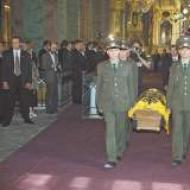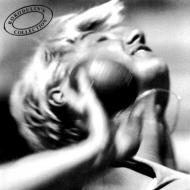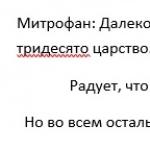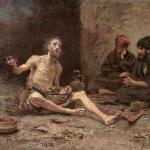
Presentation "Portrait" N.V. Gogol presentation for a lesson on literature on the topic. Presentation on the topic "Gogol "Portrait" (grade 10) the choice between good and evil
slide 2
In 1834, lively debates were going on in society about the essence of art. The story is the response of N.V. Gogol.
People of art, musicians and artists, become the heroes of romantic works. These are people of a special warehouse - smart, vulnerable, sensitive. Therefore, they are in conflict with the whole world, they are incomprehensible to others, they are despised and poor, but the truth is on their side ...
slide 3
From the "Author's Confession"
“... when I began to think about my future ... the thought of a writer never crossed my mind, although it always seemed to me that I would become a famous person ... and that I would even do something for the common good ... but as soon as I felt that in the field of the writer I can also serve the state service, I gave up everything ... "
slide 4
PART I
"Nowhere did so many people stop as in front of the art shop in Shchukin's yard."
slide 5
“Everyone admires in his own way: the peasants usually poke their fingers; gentlemen are considered seriously; the footmen-boys and the boys-workers laugh and tease each other with drawn caricatures; old lackeys in frieze overcoats look only to yawn somewhere; and the merchants, young Russian women, rush by instinct to listen to what the people are babbling about and see what they are looking at.
slide 6
“At this time, the young artist Chartkov, who was passing by, involuntarily stopped in front of the shop.”
Find the portrait of the hero.
“The old overcoat and the unsmart dress showed in him that person who, with selflessness, was devoted to his work and did not have time to take care of his outfit, which always has a mysterious attraction for youth.”
Slide 7
What did Chartkov buy?
“... A portrait in large magnificent frames ... It was an old man with a bronze-colored face, high cheekbones, stunted; his features seemed to be seized in a moment of convulsive movement and did not respond to northern power. The fiery noon was imprinted in them. He was draped in a wide Asian costume ... The most unusual thing were the eyes ... They just looked, looked even from the portrait itself ... "
Slide 8
“Tired and covered in sweat, he dragged himself to the Fifteenth Line on Vasilyevsky Island. He ... threw off his overcoat, placed the absent-mindedly brought portrait between two small canvases and threw himself on a narrow sofa, which could not be said to be covered with leather, because a number of small carnations that once attached it had long since remained by themselves, and the skin also remained on top by itself ... "
What words of his professor did Chartkov remember at that moment?
Slide 9
Slide 10
“Vivat, Andrei Petrovich! .. Chartkov became a fashionable painter in every respect. He began to go to dinners, accompany ladies to dinners and even to festivities, dress smartly and even state publicly that an artist should belong to society, that his rank should be supported, that artists dress like shoemakers, they don’t know how to behave decently ... "
What events preceded this?
slide 11
“But did I really have talent?”
- What killed Chartkov?
- What are the terrible consequences of his death as an artist?
slide 12
Part II
“Can you paint a portrait that makes me feel completely alive?”
slide 13
“... a terrible usurer entered him. You're an artist? Draw a portrait of me. I may die soon, I have no children; but I don’t want to die completely, I want to live…”
Think about whether the story "PORTRAIT" can be called fantastic? How are fantasy and reality connected in Gogol's romantic story?
Slide 14
- Which of the characters, in your opinion, becomes the spokesman for the views of N.V. Gogol to art?
- How does a romantic writer decide the purpose of art?
slide 15
extracurricular reading
- Oscar Wilde "The Picture of Dorian Gray"
slide 16
Slide 17
Oscar Wilde (real name Oscar Fingal O Flaherty Wheels) poet, prose writer, playwright (1854 - 1900).
Slide 18
Philosophical novel "The Picture of Dorian Gray"
The story of the moral fall of the aristocrat Dorian Gray. Despising morality "esthete" and clever Lord Henry becomes Dorian's spiritual teacher.
Under his influence, the young man turns into a completely immoral person. Having proclaimed the meaning of life pleasure, the hero of the novel loses the idea of good and evil.
Slide 19
Slide 20
Dorian gray has a double - this is his own portrait, which has fantastic properties, once painted by his friend the artist Hallward.
N.V. Gogol
"Portrait"
The work was carried out by the teacher of the Russian language and literature of the MBOU "Shlyapnikovskaya secondary school" Perevozchikova L.Yu.

good and evil
outside the person or inside him?

Problem
What caused the terrible fate of Chartkov?

The story of the moral fall of the artist Chartkov reflected the writer's thoughts about:
- good and evil
- true sense
human life
- moral choice
- conscience
- spiritual fall and resurrection

Vital path Chartkova
Buying a portrait depicting a pawnbroker
Became a fashionable painter
Creating a portrait of Psyche
Visit the exhibition
Creation paintings
Envy
"Artist with Talent"
Death

Path of an artist from Italy
Created a pure unblemished work of art
Chose Rafael as a teacher
Attended exhibitions
I gave everything to art
Immersed in work
becoming a hermit
Went to Italy
Had a passion for art


good
Talent
Love for creativity
The ability to create
Understanding: work-way
to perfection
impatience
Chasing fashion, fame
Comfortable life
Wealth
Narcissism
conceit
Pride
contempt for people
Envy
Desire for revenge

Conclusion
The usurer in the story is the embodiment of evil, this is the devil. The devilish beginning is strong in him. Everything that comes from him is destructive. The man who sold his soul to the devil is doomed.

Path of the icon painter
Creates a picture
where it is approved
goodness and light
Created a portrait
usurer
path of repentance and
purification of the soul
Envy
Painted pictures for the church


Conclusion
- Evil is able to take possession of any person, regardless of his moral nature - this happened to the icon painter
- The usurer is the embodiment of evil that walks the world
- You must have great strength of mind and purity of heart, otherwise evil will subdue a person.

Good and evil are eternal.
Evil is as indestructible as good.
The usurer's words are symbolic:
"I don't want to die completely, I want to live." Therefore, it is no coincidence that his portrait, stolen by someone at an auction, forever remains in the world to tempt with the brilliance of gold and light glory.

LET'S THINK
"Evil is indestructible"
"Evil can be destroyed
finally"

conclusions by lesson
Good and evil both outside and inside a person .
Human life is active
choice between good and evil.
The talent of an artist in the world can
To view a presentation with pictures, design, and slides, download its file and open it in PowerPoint on your computer.
Text content of presentation slides: NV Gogol. The story "Portrait" Three portraits of Gogol by Fyodor Moller and an oval portrait of Alexander Ivanov (1840-1841) Childhood impressions Vasily Afanasyevich Gogol married the very young daughter of the landowner Kosyarovsky, Maria Ivanovna. . On March 20, 1809, in the town of Bolshiye Sorochintsy, in the house of Trakhimovsky, a well-known doctor in Ukraine, their son Nikolai was born. The future writer spent his childhood on the estate of his parents - Vasilievka, Mirgorodsky district of the Poltava province, in those places that later became known throughout Russia from Gogol's early stories. Years of study In 1818, nine-year-old Gogol and his younger brother Ivan (soon deceased) entered the Poltava district school. Years of study. In 1821, Gogol managed to enter the Gymnasium of Higher Sciences, which had just opened in the city of Nizhyn. It was a great success: there were few such educational institutions in Russia at that time. In Petersburg. In the summer of 1828, Gogol completed his studies at the Nizhyn Gymnasium of Higher Sciences. Petersburg attracts him, it seems to Gogol that his dream of an activity that would benefit his compatriots will come true here. In December 1828 Gogol moved to St. Petersburg. Here, for the first time, a cruel disappointment awaited him: modest means ended up in big city very insignificant, and brilliant hopes were not realized as soon as he expected. Decided to publish the manuscript of the idyll. At the beginning of the summer of 1829, the book was printed and entered the bookshops. The book was published under the name of V. Alov. The responses were devastating. Shocked by the failure, Gogol collected unsold copies in bookstores and burned them. Zhukovsky V.A. and Pletnev P.A. took part in the fate of the young Gogol. With their help, he managed to leave the bureaucratic service and switch to pedagogical work. By the spring of 1831, the first part of “Evenings on a Farm near Dikanka” was completed and put into print. Most of the idyll “Hanz Kuchelgarten” was written in Nizhyn. On the way to glory Every week, friends gathered at Pletnev’s. On one of these "Wednesdays", May 20, 1831, Gogol was introduced to A.S. Pushkin. Pushkin noticed Gogol's brilliant innovation. After the appearance of Evenings .., none of his critics denied Gogol's talent. Gogol becomes a prominent figure in the literary world of the capital. History classes helped Gogol overcome his difficult mood. At the beginning of the next 1835, two famous collections were published: "Arabesques" and "Mirgorod". By the beginning of 1836 he finished the comedy The Inspector General. The first performance took place in St. Petersburg on April 19, 1836 at the Alexandrinsky Theatre. Gogol reads The Inspector General to the artists of the Maly Theater. In June 1836, Nikolai Vasilyevich went abroad, where he stayed intermittently for about ten years. In June 1842 Gogol left Russia again. Often moves from one city to another, lives in Germany, then in France, then in Italy. In the spring of 1848, Gogol returned to Russia, never to leave it again. But even at home he could not regain the lost peace of mind. In early February 1852, Gogol's health deteriorated sharply. The disease progressed. February 21, 1852 Gogol died. February 11, 1852, being in a difficult state of mind, the writer burned the manuscript of the second volume of the poem. On the morning of February 21, Gogol died in his last apartment on Nikitsky Boulevard. At the initiative of Moscow State University Professor Timofey Granovsky, the funeral was held as a public one; contrary to the initial wishes of Gogol's friends, at the insistence of his superiors, the writer was buried in the university church of the martyr Tatiana. The funeral took place on Sunday afternoon February 24 (March 7), 1852 at the cemetery of the Danilov Monastery in Moscow. A bronze cross was installed on the grave, which stood on a black tombstone (“Golgotha”), and the inscription was carved on it: “I will laugh at my bitter word” (quote from the book of the prophet Jeremiah, 20, 8). In 1930, the Danilov Monastery was finally closed, the necropolis was soon liquidated. On May 31, 1931, Gogol's grave was opened and his remains were transferred to the Novodevichy cemetery. Autolithograph by E. A. Dmitriev-Mamonov from a drawing of the 1840s. Portrait by an unknown artist, 1820s. Portrait by F. Moller. Rome, 1841. "Portrait" is not just one of the "Petersburg Tales", which refers to the appointment of the writer and his creations - it is a work where Gogol's view of the meaning and tasks of art and the Artist himself is most fully expressed. A portrait is an image in a literary work of a character's appearance Description of the face Features of the figure-clothing Manners of behavior What was his home? Was Chartkov talented? Find confirmation in the text. In the explanatory dictionary, the word "talent" is interpreted as follows: "Outstanding natural abilities, a high degree of giftedness." In the diary of M. M. Prishvin there is such an entry: “Talent is like an advance that needs to be worked out, and the more talent, the more work it means. That is why mediocre and clever people usually earn more than talented ones. For the same reason, you often hear the tale of “ruined talents”. Such talents go down because they cannot work. Talent is called a gift, because the work itself gives pleasure to a gifted and strong person. Who or what ruined Chartkov's talent? Now let's analyze the episode of creating a portrait of a young aristocrat, paying attention to the details. How does Gogol depict the process of working on a portrait? What violates the artist's work? just in passing?
Slides and text of this presentation
"The real and the eternal in the story
N. V. Gogol "Portrait". What won, what ruined and why?
The real and the eternal in the story
N. V. Gogol's "Portrait". What won, what ruined and why? * What made Gogol reconsider his attitude to the story "Portrait" and redo it?
*The image of Petersburg in the story. The theme of the city in the work of A. S. Pushkin and N. V. Gogol.
*The plot plan and composition of the 1st part of the story.
* The plot plan and composition of the 2nd part of the story.
* What connects Pushkin's novels "The Queen of Spades" and Gogol's "Portrait"?
*Painting and iconography in the story.
Study topic:
Study topic:
N. V. Gogol "Portrait".
Subject:
Literature
Members:
Pupils of 8 "B" class
Creative tasks
What made Gogol reconsider his attitude to the story "Portrait" and remake it? (booklet);
What is the difference between Pushkin's and Gogol's attitudes towards man?
(pages of the presentation);
Research assignments
for studentsWhat made Gogol reconsider his attitude to the story "Portrait" and remake it? (booklet);
The image of Petersburg in the story. The theme of the city in the work of A. S. Pushkin and N. V. Gogol. (Presentation page);
The plot plan and composition of the 1st part of the story. (Presentation pages);
The plot plan and composition of the 2nd part of the story. (Presentation pages);
What connects Pushkin's stories "The Queen of Spades" and Gogol's "Portrait"?
What is the difference between Pushkin's and Gogol's attitudes towards man?
(pages of the presentation);
Painting and iconography in the story. (Publication).
The results of the research work of students
1 group
worked on the topic
“What made Gogol reconsider his attitude to the story “Portrait” and remake it?” (booklet) and concluded:
Having left Russia after the scandal connected with the premiere of The Inspector General, Gogol finds refuge in Italy. He lives in Rome, surrounded by great works of art from different times and contemporary Russian artists who, having graduated from the St. Petersburg Academy of Arts with a medal, received a pension to improve their art in Italy. In the circle of Russian artists, Gogol was especially attracted by Alexander Ivanov, who painted the painting “The Appearance of Christ to the People”, making many sketches from nature, endlessly changing the poses of the heroes of his painting and the color that illuminates them and nature. Criticism by V. G. Belinsky and the tireless work of A. Ivanov prompted Gogol to reconsider his attitude to the story "Portrait" and remake it. By 1841, this work was completed by Gogol. The surname of the protagonist has changed: earlier his name was Chertkov, which emphasized the connection with evil spirits. Gogol excluded scenes of mystical, inexplicable appearances of the portrait and customers from the story. The syllable of the story was cleared up, the realistic characteristics of the secondary characters were developed: Nikita, the professor, the owner of the house, the quarter, ladies-customers.
N. V. Gogol is only a successor to the traditions of A. S. Pushkin. There is a whole cycle of stories where the CITY itself provokes people to deeds and misdeeds - "Petersburg Tales".
3 group
worked on the topic
The plot plan and composition of parts 1 and 2 of the story. Comparison."
The story has a two-part structure, which is extremely important for understanding the work. Having drawn up the plot plan and the composition of parts 1 and 2 of the story, we traced the path of the heroes “from talent to death”, “through trials to prosperity”. What makes the heroes go this way? Portrait! And he carries evil in himself.
The neighborhood of the first and second parts in Gogol's "Portrait" is intended to convince the reader that evil can take possession of any person, regardless of his moral nature.
2 group
worked on the topic
The theme of Petersburg in the story. The theme of the city in the works of A. S. Pushkin and N. V. Gogol” (presentation)
4 group
worked on the topic "What connects the story of A. S. Pushkin's "The Queen of Spades" and the story of N. V. Gogol's" Portrait "?"
Pushkin, in Hermann's vision, shows how mysteriously a conscience emerges in the hero's soul, interrupted by the desire to win. But a person can resist evil, he is the master of himself. Gogol writes a scene that reveals to the reader how evil takes possession of the artist, and a person cannot fight it.
6 group
worked on the topic
“Painting and icon painting in the story” The artist, whose fate is traced in the second part, is similar in height of spirit and manner of work to Alexander Ivanov, with whom Gogol so closely met in Rome and who painted the picture “The Appearance of Christ to the People”, hoping for the awakening of good the light of real truth. Constantly drawing Gogol, Ivanov made him one, then another, then the third character in the picture, but in the end he determined his place in the figure of the closest to Christ. However, the location does not determine the spiritual height of the figure. On the contrary, the manifestation of genuine goodness turns the "nearest" into a shadow, which is embarrassingly hidden in a cloak with a hood. Such was the verdict pronounced by Alexander Ivanov on Gogol.
All the paintings mentioned in the story turned out to be real: the great canvas that changed the fate of Chartkov - "The Appearance of Christ to the People" by Ivanov, "The Last Day of Pompeii" by Karl Bryullov; the icon created by the artist B. is the icon of the Nativity of Christ.
Slide #10
Final assignment for all students
What is real and what is eternal?
The real is evil.
Eternal is good.
Composition “Good and evil in the story of N. V. Gogol “Portrait”.
“... The neighborhood of the first and second parts in Gogol's “Portrait” is intended to convince the reader that evil can take possession of any person, regardless of his moral nature. And so it will always be. After all, the portrait disappears. Evil walks around the world, finding new victims...
Why is this the author? It seems to me that the author once again calls the artist for caution, attentiveness, responsibility, calls, first of all, to keep the purity of the heart, to “keep awake” in the soul.”
slide 2
Three portraits of Gogol by Fyodor Moller and an oval portrait by Alexander Ivanov (1840-1841)
slide 3
childhood impressions
Vasily Afanasyevich Gogol married the very young daughter of the landowner Kosyarovsky, Maria Ivanovna.
slide 4
.
On March 20, 1809, in the town of Bolshiye Sorochintsy, in the house of Trakhimovsky, a well-known doctor in Ukraine, their son Nikolai was born. The future writer spent his childhood on the estate of his parents - Vasilievka, Mirgorodsky district of the Poltava province, in those places that later became known throughout Russia from Gogol's early stories.
slide 5
Years of study
In 1818, nine-year-old Gogol and his younger brother Ivan (soon deceased) entered the Poltava district school.
slide 6
Years of study.
In 1821, Gogol managed to enter the Gymnasium of Higher Sciences, which had just opened in the city of Nizhyn. It was a great success: there were few such educational institutions in Russia at that time.
Slide 9
Decided to publish the manuscript of the idyll. At the beginning of the summer of 1829, the book was printed and entered the bookshops. The book was published under the name of V. Alov. The responses were devastating. Shocked by the failure, Gogol collected unsold copies in bookstores and burned them.
Slide 10
Zhukovsky V.A. and Pletnev P.A. took part in the fate of the young Gogol. With their help, he managed to leave the bureaucratic service and switch to pedagogical work. By the spring of 1831, the first part of "Evenings on a Farm near Dikanka" was completed and put into print. Most of the idyll "Hanz Küchelgarten" was written in Nizhyn
slide 11
On the road to glory
Friends gathered at Pletnev's every week. On one of these "Wednesdays", May 20, 1831, Gogol was introduced to A.S. Pushkin. Pushkin noticed Gogol's brilliant innovation. After the appearance of Evenings .., none of his critics denied Gogol's talent. Gogol becomes a prominent figure in the literary world of the capital.
slide 12
History classes helped Gogol overcome his difficult mood. At the beginning of the next 1835, two famous collections were published: "Arabesques" and "Mirgorod".
slide 13
By the beginning of 1836 he finished the comedy The Inspector General. The first performance took place in St. Petersburg on April 19, 1836 at the Alexandrinsky Theatre. Gogol reads The Inspector General to the artists of the Maly Theater.
Slide 14
In June 1836, Nikolai Vasilyevich went abroad, where he stayed intermittently for about ten years.
slide 15
In June 1842 Gogol left Russia again. Often moves from one city to another, lives in Germany, then in France, then in Italy.
slide 16
In the spring of 1848, Gogol returned to Russia, never to leave it again. But even at home he could not regain the lost peace of mind.
Slide 17
In early February 1852, Gogol's health deteriorated sharply. The disease progressed. On February 21, 1852, Gogol died.
Slide 18
February 11, 1852, being in a difficult state of mind, the writer burned the manuscript of the second volume of the poem. On the morning of February 21, Gogol died in his last apartment on Nikitsky Boulevard.
Slide 19
At the initiative of Moscow State University Professor Timofey Granovsky, the funeral was held as a public one; contrary to the initial wishes of Gogol's friends, at the insistence of his superiors, the writer was buried in the university church of the martyr Tatiana. The funeral took place on Sunday afternoon February 24 (March 7), 1852 at the cemetery of the Danilov Monastery in Moscow. A bronze cross was installed on the grave, which stood on a black tombstone (“Golgotha”), and the inscription was carved on it: “I will laugh at my bitter word” (quote from the book of the prophet Jeremiah, 20, 8). In 1930, the Danilov Monastery was finally closed, the necropolis was soon liquidated. On May 31, 1931, Gogol's grave was opened and his remains were transferred to the Novodevichy cemetery.
Slide 20
Autolithograph by E. A. Dmitriev-Mamonov from a drawing of the 1840s. Portrait by an unknown artist, 1820s.
slide 21
Portrait by F. Moller. Rome, 1841
slide 22
"Portrait" is not just one of the "Petersburg Tales", which speaks of the appointment of the writer and his creations - it is a work where Gogol's view of the meaning and tasks of art and the Artist himself is most fully expressed.
slide 23
Portrait - an image in a literary work of a character's appearance
Description of the face Features of the figure - clothes Manners of behavior Facial expressions Gestures
slide 24
What did Chartkov look like at the beginning of the story? What was his home? Was Chartkov talented? Find confirmation in the text.
Slide 25
In the explanatory dictionary, the word "talent" is interpreted as follows: "Outstanding natural abilities, a high degree of giftedness." In the diary of M. M. Prishvin there is such an entry: “Talent is like an advance that needs to be worked out, and the more talent, the more work it means. That is why mediocre and clever people usually earn more than talented ones. For the same reason, you often hear the tale of “ruined talents”. Such talents go down because they cannot work. Talent is called a gift, because the work itself gives pleasure to a gifted and strong person.
slide 26
Who or what ruined Chartkov's talent?
Slide 27
Now let's analyze the episode of creating a portrait of a young aristocrat, paying attention to the details. How does Gogol depict the process of working on a portrait? What disrupts an artist's work? How do you deal with customer complaints? What reconciles him with them? Why did Gogol describe the first portrait in such detail, while mentioning the other works of the artist only in passing?
View all slides
















